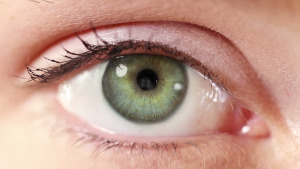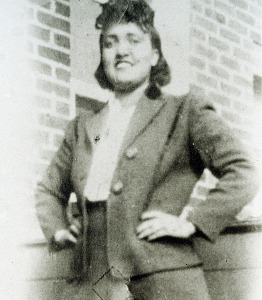|
|
|
|
|
Read More From
This Publication
Read More from All 6 SSFP Publications
Learn More
About SSFP
Subscribe/Support SSFP
|

The Biology of Human Eye Color
by Odessa Schwei, age 12
Do you ever wonder why you look the way you do? The answer to your question is DNA, which stands for Deoxyribose Nucleic Acid. DNA is what determines your hair color, skin color, and any other physical traits you possess.
Although much of your body is pre-determined by DNA, your eye color is not. The color of your eyes is determined by a self-generating liquid called melanin. Melanin is a pigment that is gray, black, or dark brown. The amount of melanin released into your eye is what controls how light or dark your iris may be. If little to no melanin is released into the iris, the colored part of the eye, then you might have blue or green eyes. If a lot is released, then you might have brown eyes.
[read more...]
|






|

Gene Therapy Reverses Childhood Blindness
by Laura A. Rivera Ruiz, age 13
One form of childhood blindness now has a cure called gene therapy. This type of gene therapy injects altered viruses into the patient's eyes. The altered viruses carry healthy genes into the retina, improving their sight.
After treatment, 90 percent of the people had improved vision. Patients described this opportunity as giving them an average life. Misty Lovelace, age 18, said, "I can honestly say my biggest dream came true when I got my sight. I would never give it up for anything. It was truly a miracle."
[read more...]
|

Stolen Cells Revolutionized Cancer Treatment
by Amanda Welch, age 14
Henrietta Lacks was an African American woman who died in 1951 from cervical cancer. Her cells, on the other hand, are still alive and continue to grow. Scientists are using her cells made huge medical discoveries decades after her death and their existence has made modern medicine as we know it today.
Henrietta Lacks was born as Loretta Pleasant on August 1st, 1920 in Roanoke, Virginia; it is unclear when she changed her name to Henrietta. At the age of four, her mother died and she was sent to live with her grandfather and first cousin, David “Day”, in an old slave house. When Lacks was 14, she and Day had their first child named Lawrence. The couple had a second child named Elsie when Lacks was 19; later marrying in 1941.
[read more...]
|

Scientists Close in on New, Universal Flu Vaccine
by Isair Medina, age 11
Keeping up with yearly flu vaccines can be tough. Getting poked by a needle feels terrible, but it is much better than catching the flu virus, which can kill you. Recently, scientists announced they may be able to develop a universal flu vaccine. This would mean no more yearly vaccines and less pain.
A vaccine works by having a weakened or disabled version of the virus introduced to your body. The immune system will fight the weakened virus and, by doing this, will learn how it can kill the real virus. The body learns to kill that virus quickly, before it can develop any symptoms.
[read more...]
|
More Recent Health Articles
Growing is important. As you go through life, your body is programmed to change its shape and size. Same goes for animals.
[read more...]
Eating cookie dough can be very tasty, but would you think that eating this treat could lead to health problems? Most likely not, and the majority of people don’t either.
[read more...]
The Black Death was one of the worst global pandemics in history. The Black Death, also known as the bubonic plague, was a calamitous epidemic that devastated Europe and Asia in the mid-1300’s.
[read more...]
Do you ever wonder why you look the way you do? The answer to your question is DNA, which stands for Deoxyribose Nucleic Acid. DNA is what determines your hair color, skin color, and any other physical traits you possess.
[read more...]
One form of childhood blindness now has a cure called gene therapy. This type of gene therapy injects altered viruses into the patient's eyes. The altered viruses carry healthy genes into the retina, improving their sight.
[read more...]
Henrietta Lacks was an African American woman who died in 1951 from cervical cancer. Her cells, on the other hand, are still alive and continue to grow. Scientists are using her cells made huge medical discoveries decades after her death and their existence has made modern medicine as we know it today.
[read more...]
Keeping up with yearly flu vaccines can be tough. Getting poked by a needle feels terrible, but it is much better than catching the flu virus, which can kill you. Recently, scientists announced they may be able to develop a universal flu vaccine. This would mean no more yearly vaccines and less pain.
[read more...]
The most common cause of death in America, cancer is a frightening and devastating disease. About 1.5 million Americans are diagnosed with cancer every year.
[read more...]
Flies are annoying- but did you know they can actually be harmful, too?
[read more...]
Are school lunches unhealthy for kids in America? Lunch programs that offer healthy and nutritious meals must follow strict guidelines. However, students at Roosevelt High School in Chicago, Illinois feel that the food they’re being served is barely edible, let alone healthy.
[read more...]
The flu pandemic of 1918 was one of the largest and deadliest in history. The influenza, or flu, pandemic infected about 500 million people—about one third of the planet’s population at that time. The flu infected more than 25 percent of the U.S. population, and more than 675,000 Americans died. The disease was first seen in Europe, the U.S., and parts of Asia. Then it spread around the world. The first flu vaccine was decades away; there was no effective treatment available in 1918.
[read more...]
Running is a very tiring task to some, though others enjoy it. Regardless of how you feel about running, researchers have found that a single hour of this activity could add seven hours to your life.
[read more...]
In the 16th century, over 400 people in Strasbourg, France ‘danced themselves to death.’ Yes, that’s right: these Frenchmen literally killed themselves by dancing.
[read more...]
When you eat a caramel apple, the first thing that comes across your mind usually isn’t contamination. However, recent research suggests that how you consume your caramel apple is something you need to worry about. In fact, it is a potentially deadly issue.
[read more...]
Can you imagine printing your dinner? 3D printing technology might soon have the power to do just that—and so much more.
[read more...]
Family trips, the flu, various appointments—these are the reasons commonly given by students seeking excused school absences. But allergies and asthma? Though it might sound odd, Sennett Middle School’s Health Office recently cited allergies and asthma as the top causes of missed school days in middle school-aged children.
[read more...]
In Flint, Michigan, people have unwittingly ingested lead-infused water due to a change of water sources. But how do they find out where people are getting poisoned and who has lead in their blood?
[read more...]
Did you know that if you practice at least three times per game you could improve your soccer skills? There are many different kinds of things you can do to better your game. Start with basic drills. “Go outdoors, grab a ball, and keep it close to your feet. That will help improve your ability to run with the ball close,” Says Hugo Grajeda, Director of Pro Youth Soccer Academy in Chester, New York.
[read more...]
Did you know that coffee, and even decaffeinated coffee, might help your liver? Yes, this bitter liquid could have some sweet benefits for those who drink three cups per day, according to a 2014 study.
[read more...]
According to a study from Northwestern University, music and audiobooks reduce pain in most patients after surgery. The study started with adults, but will be repeated to young adults and children.
[read more...]
|
|

